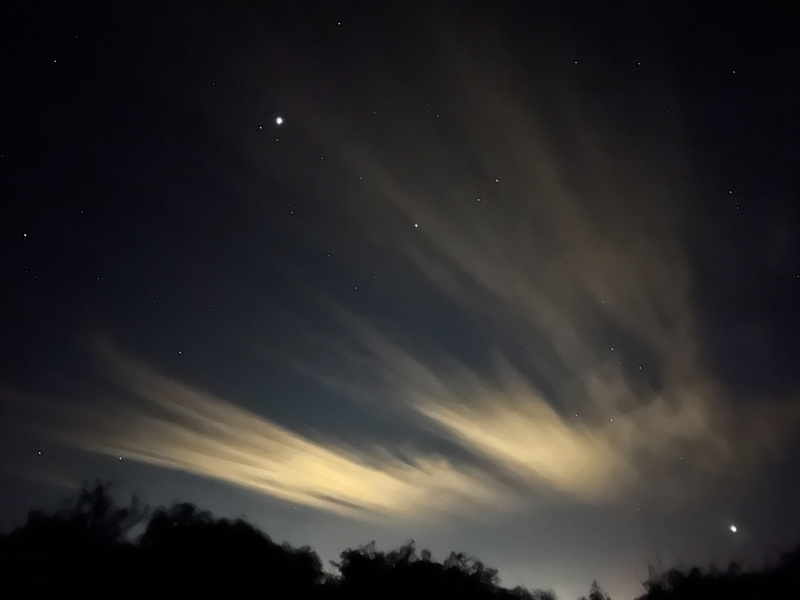Visitors, A Night of Observing
Posted: 6 November 2021
|
Open: Friday, 5 November 2021, 1713 MST Temperature: 74°F |
Session: 1688 Conditions: Mostly clear |
Equipment:
12" f/8 LX600 w/StarLock
2" 24mm UWA eyepiece
2" 14mm 100° eyepiece
Camera:
iPhone 13 Pro Max
I opened the observatory early to get ready for some visitors to Cassiopeia Observatory.
SYNCed the observatory clock to WWV time signals.
1728 MST: sunset (time approximate due to clouds).
1729 MST: LX600 ON, StarLock OFF, High Precision OFF.
Viewed Venus, 102X and 174X. Viewed Saturn, 174X. Then viewed Jupiter, 174X. The shadow of the moon IO was transiting the Jovian disk.
1736 MST: Took this iPhone 13 Pro Max photo of clouds in the southern sky. The planet Venus is visible near the upper righthand corner.

1738 MST: Wi-Fi adapter ON.
Tested the new SkySafari 7 Pro iOS app to control the LX600 telescope using the iPhone 13 Pro Max. It worked (as expected). The new SkySafari 7 Pro is available at 50% off for a limited time on the Apple App Store.
1740 MST: Wi-Fi adapter OFF.
I then relaxed on the observatory patio bench while waiting for the visitors to arrive.
1746 MST: the visitors arrived. I first told them about the site and showed them Kitt Peak National Observatory (65 miles away) and Mt Lemmon Observatory (11 miles away). Next, I explained some history of the SkyShed POD observatory. We then began a night of observing.
First, we viewed the planets Venus, Saturn, Jupiter, and Neptune, 174X.
We then viewed the following Deep Sky Objects, 174X: M57 (Ring Nebula), M13 (Great Globular Cluster in Hercules), M27 (Dumbbell Nebula). We viewed the Double Cluster (open star clusters), 102X. Next we viewed some galaxies, 102X: M31 (Andromeda Galaxy), its satellite galaxy M32, and M33 (Triangulum Galaxy). Then M76 (Little Dumbbell Nebula), 174X. The last planet we viewed was Uranus, 174X. The last object we viewed was M45 (the Pleiades), 102X. We saw many Earth-orbiting satellites from the dark sky location.
By this time, clouds were in most of the sky, as seen in this handheld iPhone photo using the Camera app (Night Mode, 3 seconds, 1X lens).

Mouseover or tap on image for labels
2015 MST: visitors left. They had a nice night at Cassiopeia Observatory.
2021 MST: LX600 OFF.
|
Close: Friday, 5 November 2021, 2029 MST Temperature: 64°F |
Session Length: 3h 16m Conditions: Mostly cloudy |
Comments are welcome using Email. Twitter users can use the button below to tweet this report to their followers. Thanks.
Cassiopeia Observatory Home Page
Copyright ©2021 Michael L. Weasner / mweasner@me.com
URL = http://www.weasner.com/co/Reports/2021/11/06/index.html
